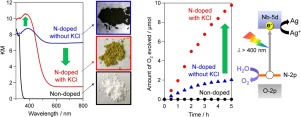Applied Catalysis B: Environment and Energy ( IF 20.2 ) Pub Date : 2018-03-08 , DOI: 10.1016/j.apcatb.2018.03.007 Hajime Suzuki , Osamu Tomita , Masanobu Higashi , Akinobu Nakada , Ryu Abe

|
In the present study, nitrogen doping into layered perovskite niobites, KCa2Nan–3NbnO3n+1 (n = 3 or 4), was attempted to enhance their response to visible light during photocatalytic water reduction and oxidation. Although conventional nitridation, i.e., heating in NH3 stream at a high temperature, produced black-colored samples due to the undesirable reduction of Nb5+ to Nb4+ (and/or Nb3+), the use of KCl flux with NH3 stream effectively prevented the reduction of Nb5+, resulting in yellow-colored samples that had a much lower concentration of reduced Nb species. The samples prepared with KCl flux exhibited stronger absorption (at λ = 350–550 nm) when compared to those prepared without KCl flux. This was due to the higher concentration of N3– anions, as confirmed by elemental analysis and the observed peak shift in XRD patterns. On the other hand, the absorption band with λ > 550 nm, which indicated the presence of reduced species or anion vacancies, were astonishingly smaller for the samples prepared with KCl than for those without KCl. This indicated that the formation of reduced Nb species was inhibited by KCl. XPS analysis also supported this effect. The use of KCl flux also prevented the problematic decrease in the concentration of potassium cations in the interlayer space during high-temperature treatment in NH3 flow. The samples prepared with KCl flux exhibited much higher O2 and H2 evolution rates under visible-light irradiation in the presence of an electron acceptor and a donor, respectively as compared to those prepared without KCl. This clear improvement in O2 and H2 evolution was probably due to the larger amount of doped nitrogen introduced and/or the suppressed formation of reduced Nb species.
中文翻译:

NH 3氮化与KCl助熔剂改善氮掺杂层状铌酸盐光催化剂的可见光活性
在本研究中,尝试将氮掺杂到层状钙钛矿铌矿中,即KCa 2 Na n –3 Nb n O 3 n +1(n = 3或4),以增强它们在光催化水还原和氧化过程中对可见光的响应。尽管常规的氮化(即在较高温度下在NH 3流中加热)会由于不希望的Nb 5+还原为Nb 4+(和/或Nb 3+)而产生黑色样品,但将KCl助熔剂与NH一起使用3流有效地防止了Nb 5+的还原,导致黄色样品中还原Nb的浓度低得多。与不使用KCl助熔剂制备的样品相比,使用KCl助熔剂制备的样品表现出更强的吸收(在λ = 350–550 nm)。这是由于元素分析和XRD图谱中观察到的峰位移证实了N 3–阴离子的浓度较高。另一方面,吸收带为λ > 550 nm(表明存在减少的物种或阴离子空位),用KCl制备的样品比没有KCl的样品小得多。这表明KCl抑制了还原的Nb物质的形成。XPS分析也支持这种效果。使用KCl助熔剂还防止了在NH 3流中的高温处理期间层间空间中钾阳离子浓度的问题降低。与不使用KCl制备的样品相比,使用KCl助熔剂制备的样品在可见光照射下在电子受体和施主存在下分别表现出更高的O 2和H 2析出速率。O 2和H 2的明显改善 可能是由于引入了更多的掺杂氮和/或抑制了还原Nb物种的形成。











































 京公网安备 11010802027423号
京公网安备 11010802027423号